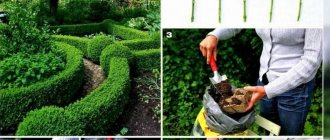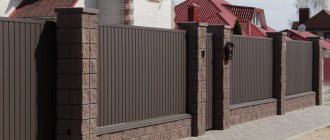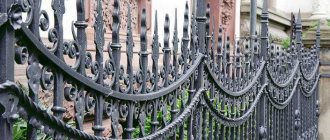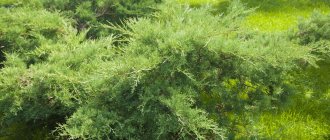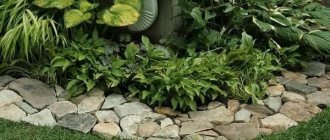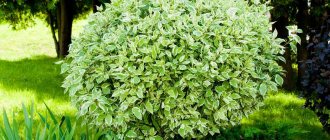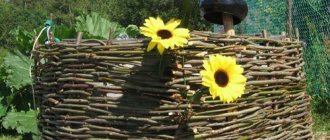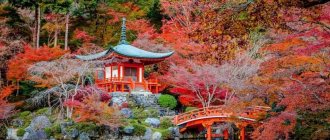A barbed fence, in addition to its aesthetic appearance, wind/dust/noise protection, will also help protect your site from uninvited guests.
A fence can become an additional barrier for people with bad intentions, as well as for wild animals who want to feast on your vegetable garden and front garden; it will also be too tough for large animals that willingly eat lush greenery from non-thorny hedges. And it will staunchly defend your country house or summer cottage in your absence.
Choosing shrubs by height
When deciding what height the plants should be, you need to focus on the size of the plot and the area that the owner will allocate for a living fence. Naturally, if taller plants are planted, this will create more shade from the green fence. In accordance with this, several types of shrubs for hedges can be distinguished:
- tall bushes. The most prominent representatives of this group of plants are hawthorn, lilac, serviceberry, and euonymus. Mature plants can reach a height of 3 m or more, which is why it is better to plant them to create a hedge around the perimeter of a country house. A fairly common option is when they are planted together with low- or medium-sized plants placed in parallel;
- medium-sized shrubs. These include currants, yellow acacia, and brilliant cotoneaster. Mature plants have a height of 2 m, so with these parameters they will help create an impressive fence for a summer cottage, providing a high level of protection;
- low growing shrubs. This group contains thunberg barberry, cinquefoil, and boxwood. As a rule, these plants are used to decorate borders on the territory of the estate; they are also used to decorate paths, gazebos and recreation areas.
Ornamental shrubs for the Moscow region
In the Moscow region, winter lasts for 5 months. Only the most frost-resistant ornamental shrubs can survive such long-term exposure to low temperatures. It is desirable that they be unpretentious; we will write about them in the next section.
Additional conditions include adaptability to gas pollution and belonging to annuals. In summer, problems with growing usually do not arise. In areas with a temperate continental climate, the average air temperature is not lower than +21 °C.
Thorny and non-thorny shrubs
If the owner plans to build a hedge for his site, then care must be taken to ensure that it has good protective properties. Based on this characteristic, two groups of plants are distinguished:
- thorny bushes;
- thornless shrubs.
It is clear to everyone that thorny bushes have needles, and therefore, by erecting a fence from thorny bushes, the owner can be confident of a higher level of protection against illegal entry by people and animals.
- thorny bushes - the best known are gooseberry, blackthorn, hawthorn, rose and rosehip.
- non-thorny. These plants are distinguished by the absence of spines or thorns. These should be considered lilac, currant, and honeysuckle.
After the issue with the height and permeability of the fence has been resolved, it is necessary to decide on the appearance of the future fence.
Shrubs with decorative flowers
To decorate your garden beautifully, you should get acquainted with popular and original garden plants that make the landscape unique and beautiful. We will advise which flowering and non-flowering ornamental shrubs to choose for specific conditions. Below are the most popular flowering perennials, photos and names, soil requirements, and cultivation.
Deciduous and evergreen shrubs
Considering that shrubs today are presented in a wide variety, the owner of the site has the opportunity to select among them plants that are more suitable for his appearance. As a basis for forming a hedge, you can choose deciduous and coniferous plants .
It is difficult to give specific recommendations here, so you need to focus on your own preferences. Among gardeners, the most common classification of shrubs is deciduous and evergreen.
Recent Entries
Chainsaw or electric saw - what to choose for the garden? 4 mistakes when growing tomatoes in pots that almost all housewives make Secrets of growing seedlings from the Japanese, who are very sensitive to the soil
Deciduous
This refers to plants that begin to shed their leaves with the arrival of autumn. Thus, the owner must take into account the fact that with the onset of winter, the hedge will no longer be as functional as in the summer, since at this time of year it will not be able to protect the house from strangers.
In the warm season, she copes with this task perfectly well, since, from early spring to late summer, the plants are strewn with colorful flowers , foliage or tasty fruits. A special coloring in the autumn period is given to the site by fading foliage, which during this period acquires a crimson or yellowish color.
Evergreen shrubs
Judging by the name, these can be considered plants that retain foliage constantly, regardless of the time of year. Within this group, two types of shrubs can be distinguished:
- deciduous;
- conifers.
Deciduous . This group of shrubs can include boxwood, Japanese euonymus, and barberry. Although such plants can decorate a hedge and will not create difficulties with cutting, they often cannot withstand the harsh Russian winters; as a result, with the arrival of spring, dead plants are discovered, which forces the owner to plant new ones.
Conifers . These include spruce, juniper, thuja, and yew. In addition to the fact that these shrubs can withstand negative temperatures and do not create problems in care, they bring considerable benefits to the site, since during their development they saturate the air with phytoncides, which have a positive effect on human health. However, to experience all the benefits of having coniferous plants on your site, you will have to be patient, since they grow quite slowly.
For landscape design, a common practice is when a hedge is formed from two or three plants that differ in their texture or height. Although if the owner decides to take such a step, he will have to prepare for certain difficulties, since it is difficult to make such a mixed hedge. You can simplify the solution to this problem if you first draw up a project on paper.
It should also be borne in mind that each plant requires an individual approach , since they have their own requirements for the composition and quality of the soil. Therefore, so that the effort and time spent are not in vain, it will not hurt to first find out which plants will feel best in your area and select plants accordingly.
Planting rules and care
When caring for a thorny hedge, there are some nuances. They are planted at a distance of 20-30 centimeters from each other, while the standard distance for a non-thorny hedge is from 40 to 50 cm.
- In the first two years, the hedge is trimmed so that it is no more than 10 centimeters above the ground.
- Throughout the season, it is necessary to remove weak shoots and leave from 2 to 4 strong shoots; this increases branch formation and will make the bush fluffy and large in the future.
- From the 3rd year we begin to form a living wall, we fix the shoots on a trellis so that the hedge will be dense in the future.
- From the 4th year we begin pruning and shaping. Adjacent branches and shoots can be tied together; the tie should not be tight so as not to harm the plant or disrupt the movement of sap.
- During the period of active growth, better care is necessary: so that the hedge does not lose its shape due to the many young shoots and so that the hedge does not go beyond its allotted boundaries.
Thorn bushes for hedges
Among all types of plantings, prickly shrubs will be the best solution for creating an external impenetrable hedge. Although many of them are not afraid of being cut, they have the most attractive appearance when growing wild. Among them there are also those that grow in width, which is why the owner is required to regularly trim them and monitor the area of growth .
- blackthorn. This cold-resistant plant has a highly branched structure and reaches a height of 4 m. The bushes are easy to care for. As it grows, it forms dense, impenetrable hedges that provide good protection for the area from the wind. This shrub can be used as an external fence for the area. Flowering occurs before the leaves form: at this time, abundant white flowers are formed, while the fruiting phase occurs in August. The fruits of the bush can be used for food;
- sea buckthorn. This shrub is one of the unpretentious ones. Seeds can be used for propagation. Provides a beautiful view to the site when used as a hedge placed in two rows. The fruits, as well as the leaves, have a very attractive appearance. The berries are used for food and also serve as raw materials for preparing medicinal decoctions and infusions. To form the boundaries of the fence, sea buckthorn must be regularly pruned, however, such an operation has a negative impact on the yield;
- roses. This type of shrub can have different heights. This group usually includes a large number of varieties, among which there are low-growing, standard and climbing varieties. Thanks to the wide variety, the owner has the opportunity to create on their basis not only an impenetrable living fence, but also a beautiful border. Among the varieties of roses there are those that need to be covered for the winter. Pruning bushes does not have a negative effect on the plant. During flowering they have an attractive appearance.
Exotic shrubs for the garden
Each garden plot can be made unique. To create an unusual landscape design, you need to plant exotic plants that match the preferences of the summer resident. Their list is quite extensive.
tree peony
It belongs to the same genus as herbaceous perennial, etc. Peony. The height of the bush is no more than 1.5 m. The flowers decorating the bushes are pink, burgundy and yellow. Corolla diameter 30 cm.
Double flowers vary in color. The number of shoots on one plant is from 3 to 5. The width of the bushes can reach 2 m. Among the distinctive features are a charming aroma, unpretentiousness, and resistance to adverse weather conditions.
Camellia
The flowers of this plant consist of dense petals. The spectrum contains all shades of red and cream. Mixed color camellias are similar to gardenias. The oval leaf blades have a leathery surface.
Hibiscus (Chinese rose)
The assortment of specialized stores includes annual and perennial varieties. The former are flowering plants, the latter are shrubs. During the flowering period, the bushes are covered with bright, large corollas.
Acacia
The plant, which attracts bees with its unusual aroma, belongs to the legume family. Height 30 m. Features include white inflorescences and thorns on the branches.
Rhododendron
Quite whimsical. Needs an acidic environment, moisture and fertilizers. Frost-resistant varieties and their hybrids are suitable for growing in the Moscow region.
Prickly plants with thorns
Details Category: Articles about plants Published: August 29, 2016
| Prickly plants with thorns |
A thorny plant is any plant with spines or thorns on any part of the plant. What types of plants have thorns and thorns? There are a lot of different plants with thorns and thorns in the world. Large and small plants, herbaceous and shrubby, medicinal, weedy, poisonous and simply well-known and very rare plants. These cute thorns and thorns serve as protection for plants and can cause a lot of trouble for those who decide to disturb these thorny plants. This page of the site presents commonly found prickly plants with thorns.
| Brief description and photo of thorny plants | ||||||||||||||||||||||||||||||
|
Unpretentious
For many gardeners, it is fundamentally important to plant exclusively unpretentious plants on the site. Everyone has their own reasons for this. Some people rarely go out of town, so there is no time to care for them. Others don't like all this hassle. Still others are beginners who are afraid of doing something wrong. They usually rely on the natural characteristics of the plants chosen for the hedge.
First of all, frost-resistant shrubs are considered unpretentious. Their undeniable advantage is that they tolerate winter well. This preserves the decorative appearance of the hedge, since those plants that are sensitive to low temperatures may die, and unsightly gaping empty spaces appear in the green fence. What gardeners advise you to choose:
- common heather;
- rhododendron;
- rose hip;
- hawthorn;
- euonymus;
- Chinese juniper, scaly;
- yew berry.
The second criterion for unpretentiousness is the ability to grow luxuriantly both in sunny places and where rays cannot penetrate. After all, hedges often have to be planted near walls, so it is better to initially select shade-tolerant shrubs:
- winged euonymus;
- white snowberry;
- honeysuckle;
- Mexican jasmine;
- hazel;
- common privet;
- elder.
Pruning is one of the most difficult hedge maintenance procedures. In order not to suffer too much with it, it is enough to create it from bushes that do not require regular trimming:
- Spiraea Wangutta;
- kalmia;
- bush caragana;
- Chokeberry;
- Mexican jasmine;
- Thunberg barberry.
To create an unpretentious (and free) hedge, you can use shrubs brought from the forest:
- derain;
- rose hip;
- hawthorn;
- black and red chokeberry;
- blackthorn;
- blackberry.
No matter how simple a plant is to care for, it will still need help in such a dense planting. At a minimum, crown ventilation and prevention of fungal diseases.
Barberry Thunberg. Deciduous plant from the Barberry family. Beautiful and at the same time unpretentious. The shoots are distinguished by a bright red hue. The diamond-oval leaves attract attention with their emerald green. Delicate yellow flowers turn into deep ruby oblong fruits in September.
Articles on the topic: Hedge - what to plant from?
Depending on the growth rate
Since most hedges are created with the goal of protecting the area from anyone or anything (neighbors, animals, noise, snow, wind, etc.), fast-growing shrubs become the priority choice. These include:
- Thunberg barberry;
- rose hip;
- European beech;
- vesicular carp;
- common hornbeam;
- hawthorn;
- snowberry;
- Leyland's cupressociparis;
- cherry laurel;
- Thuja occidentalis Brabant.
Shrubs of moderate growth (you will have to wait 3-4 years) include:
- common privet;
- viburnum;
- Tatarian honeysuckle;
- Elf angustifolia and silver;
- broom;
- alpine currant;
- Tatarian maple.
If there is nowhere to rush, you can plant slow-growing shrubs as a green fence, but gardeners rarely resort to this step:
- irga;
- mahonia holly;
- brilliant cotoneaster;
- red cedar;
- holly;
- boxwood;
- sea buckthorn;
- yew.
Fast-growing shrubs as part of a hedge are also beneficial because if one plant disappears, a young shoot can be planted in its place - and it will soon close the gaping hole. This will not work with slow-growing ones.
Shrubs with decorative leaves
Below are types of shrubs with very decorative leaves that effectively decorate the landscape of a garden or dacha.
Evergreen boxwood
An evergreen, slow-growing boxwood with tiny, ovate, shiny, dark green leaves makes an effective landscape addition. The bush tolerates pruning well and is suitable for creating decorative trimmed green hedges and designing the boundaries of plots. Boxwood can be easily formed into various shapes. The plant develops well in sunny exposure and shade. Loves calm, windless, damp positions.
Cotoneaster brilliant
It grows to a height of 1-2 meters, has dark green, shiny leaves, turning into dark red, orange, and yellow in autumn. Sunny or semi-shaded places are suitable for cotoneaster. The plant is completely resistant to frost and drought. It tolerates pruning well - this is one of the best deciduous shrubs for continuous hedges.
Euonymus Fortune
Evergreen, dense, slow-growing, creeping shrub. The leaves are leathery, small, ovate or elliptical. Euonymus is planted individually or in groups as a border decoration, gazebo or hedge. Grows in sunny and semi-shaded places.
Barberry Thunberg
A highly branched shrub with small leaves collected in several bunches. An additional decoration of barberry is the bright red, shiny fruits that appear in the fall. Numerous varieties differ in leaf color:
- dark green;
- red;
- rose red;
- orange-red;
- golden green;
- light green.
The bush is planted separately or in groups. Great for hedges. Planting and care are simple, it grows best in sunny exposures, and can be planted in semi-shaded areas.
Bladderwort viburnum
There are many varieties of bladderwort, differing in the height of the bush (from 1 to 3 meters), the color of the leaves:
The bladderwort has no special requirements for soil or location. Can grow in sunny and shady places. Resistant to frost and drought.
Features of planting shrubs
In order for the hedge to be fully formed in the shortest possible time, it is important not only to choose the right plant, but also to plant it. Basic landing rules:
- First of all, you need to choose the right place. If the bush loves the sun, then the area should not be in the shade. Dwarf plants require less space than bushes with a wide crown.
- It is better to plant a fence in a trench, having previously marked the area with a cord and several pegs.
- If there is excess moisture in the area, drainage (broken brick, crushed stone and sand) should be laid at the bottom of the trench.
- The optimal planting time for most ornamental bushes is spring, after the snow melts, when the threat of return frosts has passed.
- The density and planting pattern depends on the growth of the shrub. Taller plants are planted 2-3 per linear meter, and medium-sized plants - 4-5.
When preparing the soil, you need to focus on a specific type of plant. Some people like acidic soil, others like neutral soil.
Mixed fast-growing shrub hedges
Sometimes two or three plants are combined in a planting, which can alternate or create an asymmetrical composition.
The easiest way to put together a stylish mix is to play with a contrasting combination. For example, choose an interesting color pair. A heterogeneous wall with fragments of different textures looks impressive.
To do this, you can combine coniferous and deciduous trees. Let's say juniper with blue needles and golden Thunberg barberry, red-leaved bladderwort or red turf and thuja with bright green needles.
The planting can be composed of plants of the same species, but of different varieties. If you select bushes that differ only in color, but not in the shape of the leaves and crown, the hedge will be duplicated in different colors. The main thing is not to get carried away by diversity.
For example, if a shrub has edged leaves, it will look advantageous next to a plain crown that repeats one of its two colors.
You can take a risk and combine two-color plants. For example, two barberries: one has burgundy leaves with a lemon edge, the other has yellow leaves with a wine-colored edge.
It is more convenient to work with a hedge that consists of bushes of equal height and density.
But combinations of plants of different sizes are also possible, for example, lilac with forsythia or mock orange.
Which shrubs to choose?
Before you go to the gardening store, there is an important issue to think about. How much time can we spend on gardening? Many garden plants require lengthy agrotechnical procedures.
- If you need to plant a light and pleasant garden, you should choose coniferous shrubs and other plants that do not require careful care or regular intervention.
- If you have the opportunity to work a lot in the garden, you should choose exotic, demanding shrubs that create an excellent showcase for the garden.
